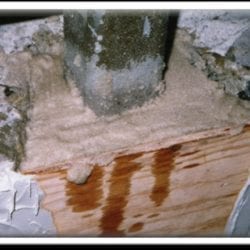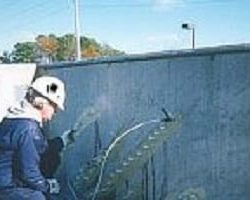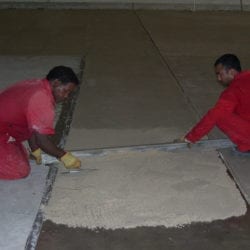USES
Chem-Button is designed to be used as an epoxy adhesive for fixing raised traffic reflectors, fixing flat studs or studs with lugs, bonding lane markers, temporary bonding of rubber warning cones, etc. Chem-Button is also used as dowel setting adhesive in horizontal applications. The product may be extensively used in the fields of:
- Highways and roads maintenance.
- Bridges and tunnels maintenance.
- Airports and airbase maintenance.
- Bonding of wood, concrete, steel, glass, asphalt and most construction materials.
TECHNICAL
Data for Unmixed Parts
| Technical Data @ 25°C |
Resin – Part A |
Hardener – Part B |
| Solids, % |
100% |
100% |
| Color |
White |
Black |
| Density, Lb/Gal (Kg/L) |
12.9 (1.55) |
12.5 (1.50) |
| Shelf life |
Two Years |
Two Years |
| Mix ratio (A:B) |
1:1 by volume |
Technical Data for Mixed Parts
| Properties @t 25°C |
Values |
ASTM Method |
| Density, Lb/Gal (Kg/L) |
12.6 (1.52 |
D-1475 |
| Color |
Grey |
–
|
| Pot life @ 60 grams, minutes |
12 |
N/A |
| Shore Hardness |
77-D |
D-2240 |
| Flexural strength, Psi (MPa) |
2690 (18.3) |
D-790 |
| Compressive strength, Psi (MPa) |
5070 (34.5) |
D-695 |
| Bond Strength to steel, Psi (MPa) |
320 (2.2) |
C-321 |
| Bond strength, (24 hours) |
1220 (8.3) |
C-881 |
| Water absorption @ 24 hours, % |
0.035 |
D-570 |
| Elongation, % |
33 |
D-522 |
APPLICATION
Limitations: applications at ambient temperatures below 40°F (4°C) is not recommended. Exposure to temperatures exceeding 155°F (68.5°C) for prolonged period is not recommended.
Pre-treatment of Substrate:
Concrete Surfaces: The substrate must be clean, dry, free from grease or oil, etc. Laitance and loose particles must be removed by either sandblasting or mechanical grinding. Holes must be cleaned using oil free compressed air.
Steel Surfaces: All steel surfaces to be bonded with CHEM-BUTTON must be clean, dry, free from rust, oil, grease, etc. Shot blasted to Swedish Standard SA 2 ½ is preferable to achieve a white metal finish prior to application.
Mixing: stir each component separately. Mix one part A and one part B by volume into a clean mixing container. Mix the epoxy with a slow speed electric drill with a mixing paddle attachment. Carefully scrape the sides and bottom of the pail during mixing. Blend for 3 minutes.
Note: large batches of epoxy will cure much faster than small batches. Mixed epoxy will cure much faster in hot weather than in cold weather.
Application: the mixed CHEM-BUTTON can be applied manually. Should there be a necessity of using automatic metering equipment, the un-mixed CHEM-BUTTON should be
dosed into the automatic metering equipment -which ejects part A and part B in equal volumes- fitted with a static mixer.
Fill 2/3 the hole with CHEM-BUTTON mixture ensuring no air entrapment. Insert the stud lug in a twisting motion. Extra adhesive must be applied on the surface for fixing the stud onto the surface.
Dowel Setting Application: application can be made by mechanical, pneumatic dosage equipment, caulking guns or by hand. Forces the mixture into drilled hole then insert the steel bar with a twisting motion to ensure intimate contact and a good bond without air entrapment. Lightly tap the anchor/dowel to ensure complete embedment. Wipe off any excess material from the surface and finish to a neat smooth surface.
Bonding of any similar/dissimilar material: Ensure both surfaces to bond are clean and free of dust, oil, grease, etc. Roughen up the surfaces for good mechanical keying. Apply in thin layer CHEM-BUTTON on both surfaces. Pull them together and hold into position undisturbed for 6 – 8 hours.
Curing: The gel time of CHEM-BUTTON at 77ºF (25ºC) is approximately 2–3 hours. Traffic may be opened in 4 – 6 hours after mixing and placing (at elevated temperature it would be sooner).
Cleaning: remove uncured CHEM-BUTTON from tools and equipment with a suitable solvent such as Xylene or Toluene immediately after use. Cured material may only be removed mechanically.
STORAGE
Store CHEM-BUTTON in a dry area between 50ºF (10ºC) and 77ºF (25ºC). Protect from direct sunlight. Shelf Life is two years in unopened container.
SAFETY
After full curing the product is physiologically harmless. Keep the resin and hardener away the eyes, mouth and skin. Do not inhale vapors. Uncured mixture can cause irritation of the skin. The best precaution is to wear safety protective gloves, overall, mask and goggles while working. Skin contamination should be immediately cleaned with soap and plenty of water. The use of solvents should be avoided. If resin or hardener splashes into the eyes, wash immediately with running water. A Doctor must be visited in all cases.
WARRANTY
LIMITED WARRANTY: International Chem-Crete Inc. warrants that, at the time and place we make shipment, our materials will be of good quality and will conform to our published specifications in force on the date of acceptance of the order.
DISCLAIMER: The information contained herein is included for illustrative purposes only and, to the best of our knowledge, is accurate and reliable. International Chem-Crete Inc. is not under any circumstances liable to connection with the use of information. As International Chem-Crete Inc. has no control over the use to which others may put its products, it is recommended that the products be tested to determine the suitability for specific applications and/or our information is valid in particular circumstances. Responsibility remains with the architect or engineer, contractor and owner of the design, application and proper installation of each product. Specifier and user shall determine the suitability of the product for specific application and assume all responsibility in connection therewith. AM2419.





